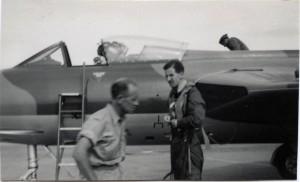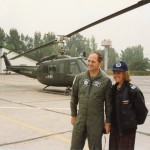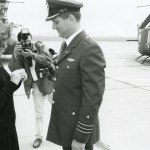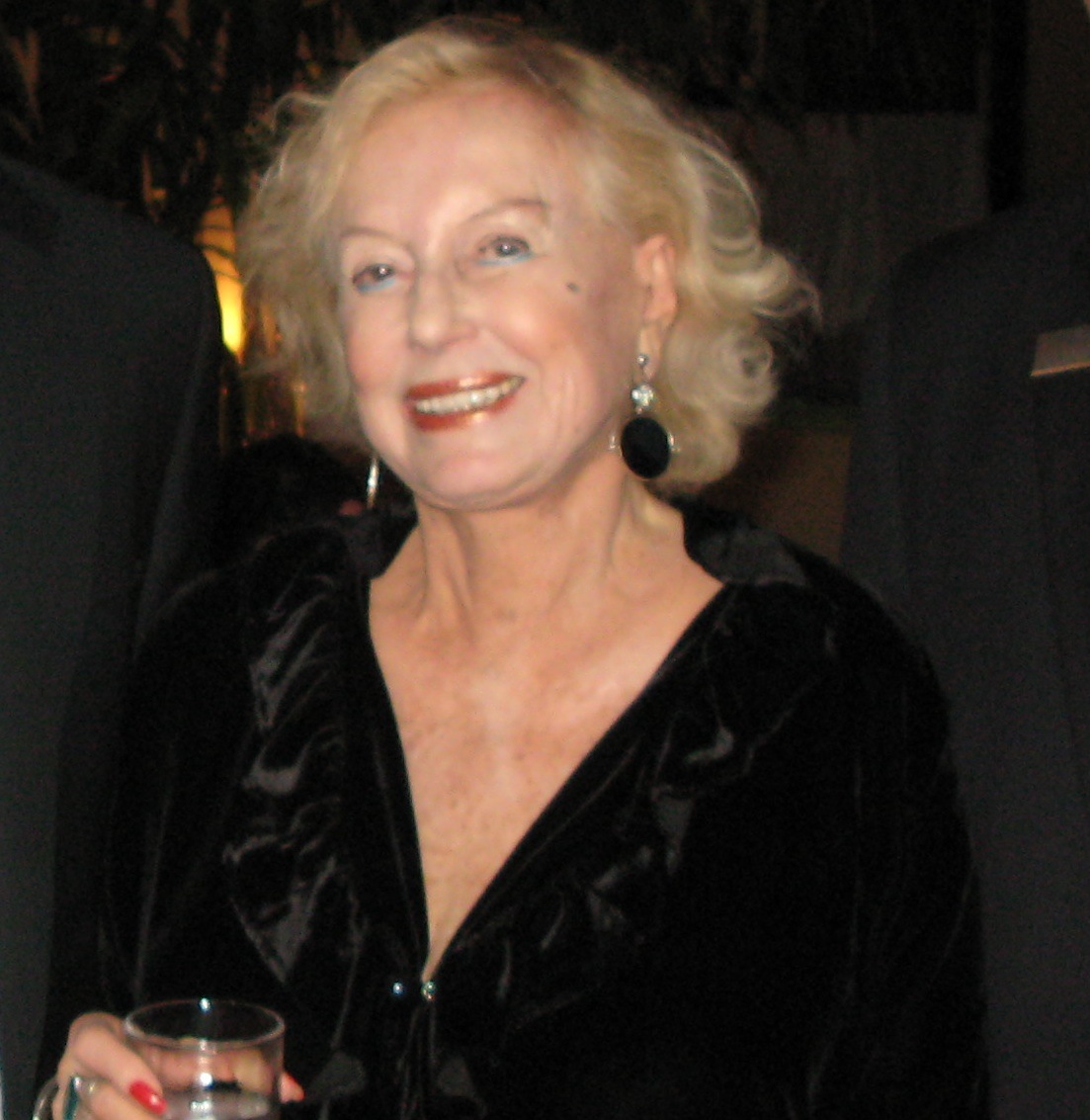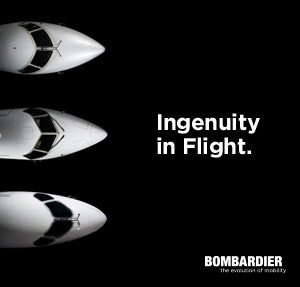Hawker Hunters over Peru
March 6, 2013
Hawker test pilot DUNCAN SIMPSON recalls a posting to South America in 1956 to oversee the introduction of the Hunter Mk 52 into Peruvian Air Force service — “five of the most difficult months of my life . . .”
By late 1955 the first of the reconditioned ex-RAF Hunter F.4s purchased by Peru, designated Mk 52s, were ready to be delivered, so at the beginning of March 1956 I started preparing to depart for South America, where I was to oversee the assembly of the aircraft and train the pilots of the Peruvian Air Force to fly them. By mid-April I was ready to begin the Hunters’ test-flying programme. It was a critical moment. Limatambo was essentially a civil airport and the loose gravel surface of the runways was hardly ideal for jet aircraft, although its length of 2,000yd (6,000ft — 2,200m) was adequate. Both runways were flanked on either side with a flourishing cotton crop, and the undershoot and overshoot areas had their share of obstructions, including a 10ft (3m)-high brick wall at one end.
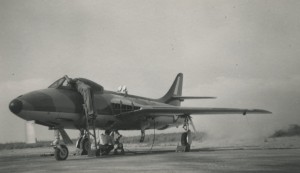 I could afford to wait until the weather conditions were good to start the flying programme — which was just as well, as there were no navigation aids and no radar. Eventually, on April 18, 1956, I made the first flight of the first of the 16 Hunter Mk 52s, from Limatambo airport.
I could afford to wait until the weather conditions were good to start the flying programme — which was just as well, as there were no navigation aids and no radar. Eventually, on April 18, 1956, I made the first flight of the first of the 16 Hunter Mk 52s, from Limatambo airport.
On May 22, Peruvian pilots made six flights in the new fighters, led by the Group Commander, Col Fernando Paraud, a likeable rogue who had previously flown a 20min sortie in a Hunter at Dunsfold. He and his colleagues, Mayor Leon Melgar and the Flight Commander and senior pilot, Capitán Alberto Thorndike, very soon completed the conversion course and later flew each aircraft on an official acceptance check. I had to do all the briefing; fortunately the standard of pilots, who were all trained in the USA, was high.
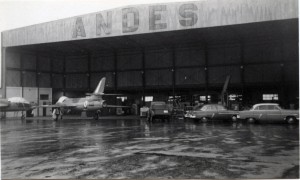
While supervising pilot conversion I continued to fly the aircraft after they were assembled. I did enjoy being let loose from the daily frustrations at Limatambo. I had to take infinite care over the test flying; the luxuries at Dunsfold just did not exist in this fascinating environment. Usually I would climb to 50,000ft to the south, with the Andes to my left and the Pacific Ocean to the right, ending up overhead the settlement of Pisco. In the event of problems arising I had no emergency retreat, apart from returning to Limatambo. I usually took time off at the end of each test flight to fly out over the Andes, the massive mountains rising to 20,000ft. Unlike the Alps, the snow level was very high, so the mass of mountains appeared to be a variety of shades of brown rock stretching as far as the eye could see. Frequently I could see signs of human building in the most remote and inaccessible places — possibly Inca remains.
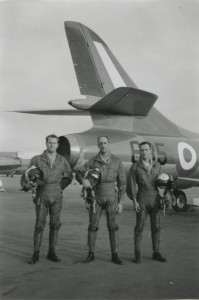
For the full previously unpublished story, illustrated with the author’s photographs, see Hunters Over the Andes in Issue No 2 of The Aviation Historian — www.theaviationhistorian.com
A-29 Super Tucano victorious
February 28, 2013

Embraer, in partnership with Sierra Nevada Corp, have been announced the winner of the contest to supply 20 aircraft to serve the Afghan military under the Defense Light Air Support programme run by the US Department of Defense. The A-29 Super Tucano has been selected over Beechcraft’s AT-6B Texan II Light Attack Aircraft. This success was confirmation of the company’s earlier selection (this first decision was challenged unsuccessfully by Beechcraft).
Deliveries of the first batch are expected to be completed by April 2015.
The Super Tucano is highly capable in the light Close Air support mission and serves with several air forces, mainly in South America.
Donaldson Barrier Filters Assist Australian Aerial Firefighters
February 28, 2013
ST. LOUIS, Mo., February 27, 2013 – Donaldson Aerospace & Defense, a division of Donaldson Company, Inc. (NYSE: DCI) continues to provide critical engine protection for helicopter operators battling Australian wildfires this year. The company’s Inlet Barrier Filter (IBF) systems are the choice of firefighting operators worldwide and heavily utilized in corporate, air medical, utility and maritime/offshore missions as well.
Donaldson IBFs support maximum aircraft availability for aerial firefighters including the brave pilots and crews at Australia’s Commercial Helicopters.
“The past couple of months’ very dry weather combined with high, dense grass cover has led to an increased number of bushfires, which is keeping us very busy,” stated Commercial’s President Marc Rogers. “Several of our helicopters have been flying over 10 hours per day on firefighting duties.”
“Our company specializes in operating in very remote, harsh conditions such as those seen in firefighting, and we wouldn’t consider operating our helicopters without Donaldson inlet barrier filters,” added Rogers. Crews are flying missions from bases in Cooma, Bombala, Tumut, Narramine, Hobart, Tasmania as well as the company’s headquarters in Mudgee.
The IBF helps prevent engine damage in adverse environments and ramp take-off and landing conditions alike, as well as reducing the effects of salt-air ingestion. IBF-equipped operators can experience lower aircraft operating costs without performance penalties. Turbine engine manufacturers regularly recommend protecting their power plants with IBFs.
Rogers and team are ready for other assignments when not fighting bushfires. The company’s Bell JetRanger and LongRanger ships perform aerial spraying, power line surveys, feral animal control and mining/exploration support in the desert area of South Australia.
“Much of this activity is very remote work and can be extremely hot this time of year, over 50 degrees Celsius or 122 Fahrenheit, meaning we need maximum turbine airflows combined with maximum protection,” adds Rogers. “It is also an incredibly dusty environment. We couldn’t operate without IBFs installed otherwise we’d suffer severe damage to our engines and unacceptable operating costs.”
Providing the most comprehensive line of IBF solutions, Donaldson Aerospace & Defense is the industry leader in the design, development and manufacture of high-performance engine IBF systems for commercial and military propulsion systems. Through its St. Louis, Missouri location, Donaldson provides certified IBF solutions for the AgustaWestland AW109E/S/SP, AW119 Koala, AW119Ke and AW139; Bell 205A1, 206B, 407, 206L-3/4, 206L-1(C30), 206LR, 230, 429 and 430; Eurocopter EC130, AS350 B/BA/B1/B2/B3/B3e, AS350s with Soloy or Heli-Lynx Honeywell engine conversions; and MD Helicopters MD 369H Series, MD 500D/E/F and MD 900/902.
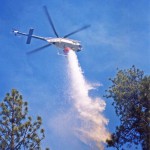
Uma História de um Entusiasta da Aviacao de 13 Anos
February 19, 2013
Ola
Meu nome é Lucas Rodrigues, tenho treze anos e estou no 9 ano do colégio.
Gosto muito da Revista de vocês. Com matérias bacanas e interessantes.
Eu também sou um pouco diferente. Como diz meu pai, um pouco maluco das ideias.
Acho que vocês poderiam publicar uma matéria minha. É a história de um menino que desde que nasceu tem uma paixão diferente e especial. A Revista de Bordo da TAM já publicou quatro páginas da minha história e o astronauta Marcos Pontes também publicou uma entrevista comigo no blog dele.
Sou um estusiasta da aviação. Gosto tanto, mas tanto, que hoje estou montando um museu. Um Museu da Aviação.
Tudo começou quando eu ainda estava dentro da barriga de minha mãe quando eu tinha três semanas. Meus pais estavam viajando ao Rio de Janeiro para comemorar meu futuro “pouso” na nossa família.
Depois um dia meu pai me contou a história do naufrágo que escreveu uma carta e colocou dentro de uma garrafa……Pois eu fiz o mesmo, mandei um SOS para o mundo inteiro, foram mais de 13.000 e-mails.
E funcionou. Visitei várias empresas de aviação, conheci muita gente, Presidentes, Diretores, Gerentes, operações. Aprendi que terei que estudar muito, mas muito mesmo, dominar o inglês, inglês, que todos os manuais são em inglês….
Conheci a logística das companhias aéreas. Sabe, nós passageiros, pensamos que tudo é fácil e simples, que é só fazer o check-in e embarcar. Que nada!!!! Conheci os procedimentos desde a escala da tripulação até o nosso embarque. Já cheguei a decolar, pilotar e pousar um avião de verdade, claro num simulador profissional. Tive até treinamento de Brigadista, com simulação de evacuação de uma aeronave.
Todos os anos vou duas ou três vezes a Porto Alegre visitar meus avós, e nunca deixo de ir na cabine dar um abraço na tripulação. Já cantaram até feliz aniversário a bordo.
Meu sonho é ser piloto.
As vezes eu penso, como Presidentes e Diretores de empresas aéreas puderam me receber, até o Astronauta Marcos Pontes. Tudo isto está no meu blog. Acho que a minha história é bem legal e quem sabe pode ser contata por sua revista.
Hoje eu tenho amigos no mundo inteiro. Recebi presentes de vários países, na verdade dos cinco continentes. Meu blog foi acessado por mais de 50 países. Hoje eu tenho uma coleção de mais de 50 maquetes, camisetas, lápis, canetas, cadernos, cartõess, poster, bonés, revistas, bolsas, pen drive, cartas, postais e muito mais. Tenho de tudo. Até um sorvete da Nasa que ganhei do Marcos Pontes. Eu gostaria mesmo é de ter podido dar um lance no leilão da Vasp e ir morar no Congonhas, dentro de um avião. No ano passado até tentei convencer meu pai a dar um lance, mas não teve jeito não.
As vezes eu penso se Santos Dumont e outras pessoas não tivessem sonhado hoje talvez nem tivéssemos os aviões.
Também aceito qualquer lembrancinha para aumentar meu pequeno grande museu.
Lucas Carvalho Rodrigues
Unimos nuestro apoyo al 787
February 6, 2013
En Revista Aérea, unimos nuestro apoyo al 787 y por la pronta solución del problema que los mantiene en tierra en este momento.
Boeing, con su firme y acertada seriedad, llegará al fondo del problema, y el 787 será uno de los mejores aviones de todos los tiempos.
El Homeowner Referral Network® (HRN) Business se expande a América Latina
February 4, 2013
Ex-ejecutiva de Revista Aérea anuncia el lanzamiento de refprocasa.com
Este año marca el décimo-séptimo aniversario de que Debra Dicker-Cohen tomara la difícil decisión de dejar su carrera en Revista Aérea por una actividad algo menos glamorosa – la maternidad. No obstante, poco después de dejar Revista, Debra comenzó su propio negocio desde el sótano de su hogar y lanzó Home Remedies of NY®, Inc., la primera empresa de Referencias para Propietarios de Casa (Homeowner Referral Network, HRN, según sus siglas en inglés) de su tipo. Desde ese discreto comienzo, el negocio HRN® de Cohen ha crecido y actualmente existen más de 300 empresas como el de Debra operando en el mundo, con las más recientes apareciendo en Canadá y Australia. Ahora, en un esfuerzo para ayudar a los empresarios latinoamericanos que buscan la posibilidad de desarrollar un negocio desde su hogar, Cohen está introduciendo el concepto HRN® a América Latina a través de www.refprocasa.com.
Antes de salir de Revista, Cohen había adquirido su primer inmueble. Como nueva propietaria, se sintió rápidamente frustrada con contratistas poco confiables que a veces faltaban a sus citas o cobraban tarifas exorbitantes por sus servicios. Finalmente, su experiencia le inspiró a crear su propio negocio que pudiera ayudar a los propietarios locales a encontrar buenos contratistas y ayudar a los contratistas confiables a promover sus servicios.
�
En 1996 preparó el plan empresarial para una Homeowner Referral Network® que pudiera pre-evaluar y referir a profesionales, incluyendo plomeros, pintores, carpinteros, electricistas y contratistas generales. Los contratistas referidos por la HRN pagarían una comisión predeterminada por cualquier tarea contratada, de modo que los servicios que ella proporciona a los propietarios resultan gratis. Recibió una tremenda demanda para sus servicios , y a solo un año de establecida, tenía más trabajo del que podía manejar. En vez de tratar de crecer demasiado rápido, Cohen decidió duplicar el modelo empresarial al crear un Paquete Empresarial (Business-In-A-Box). Documentó todas las instrucciones de cómo comenzar y operar una HRN en un manual empresarial abarcador, “La guía completa para poseer y operar una Red de Referencia para Propietarios de Casa©” exitosa, y empezó a ofrecerla a otras personas interesadas en crear un negocio viable desde su propio hogar.
“Me di cuenta que no sólo existía una gran demanda por los servicios ofrecidos por una HRN, sino además que mi negocio resultaba atrayente para otras personas que buscaban algún tipo de negocio viable que pudieran desarrollar desde su hogar. Los interesados incluían desde amas de casa, retirados, personas que cambiaban de carrera, e incluso contratistas que ya no podían realizar las labores físicas exigidas por su profesión”.
Existen más de 300 HRN independientes como la de Cohen en operación en el mundo y cada una se beneficia de una amplia gama de servicios de apoyo, tales como consultas personales, diseño de sitos web para la HRN, una publicación trimestral, HRNewsletter, exclusivamente para propietarios de empresas HRN, formularios pre-impresos, y otros servicios comerciales. Cohen incluso ha creado un programa de computadora en línea, HRN Management Software (HRNMS©), para ayudar a los propietarios de HRN a organizar y manejar su información sobre contratistas y propietarios de casa, referencias de trabajos, comisiones por cobrar, entre otros detalles. La publicación “La guía completa para poseer y operar una Red de Referencia para Propietarios de Casa©” y otros materiales de mercadeo para una HRN están disponibles en español.
Cohen dice, “Existe una necesidad universal por encontrar buenos contratistas y resulta asombroso como el modelo empresarial de una HRN funciona en comunidades tan diversas en el mundo entero. Ahora, con la inauguración de refprocasa.com, mi objetivo es compartir esta singular propuesta empresarial con otras personas en América Latina en busca de su propio negocio, y volver a trabajar con el mercado hispanohablante que tanto he extrañado estos últimos 17 años”.
El negocio de HRN ha sido destacado en las revistas Good Housekeeping, Remodeling y Working Woman, por mencionar solo algunas. Cohen también ha aparecido en CBS News, CNN y el programa New Attitudes del canal Lifetime.
Para más información sobre negocios HRN, visite www.refprocasa.com o comuníquese con Debra Cohen en EE.UU. llamando al 1+ (516) 374-8504 o por correo electrónico a debra@hrnbiz.com
�
�
�
�
�
�
�
Alenia Aermacchi: new version of SF-260 with glass cockpit completes first flight
January 29, 2013
Alenia Aermacchi’s SF-260TP primary and basic trainer, equipped with new digital avionics (Glass Cockpit), an enhanced multi-spectral vision system and an upgraded air conditioning system has completed its first flight in Venegono, Italy. The aircraft is in final testing stages, and potential customers have requested demonstrations of it.
�
The aircraft is equipped with new digital avionics that will increase the SF-260’s competitiveness and will allow the aircraft to play a greater role in the global trainer market.
�
The new cockpit’s layout, based on an integrated digital avionic system, features two large LCD displays (6�8 inches) and one Control Display Unit (CDU) that manage several of the aircraft’s functions. Two Integrated Flight Displays (IFD) incorporate radio, VHF Omnidirectional Range radio-guide (VOR), GPS, and Inertial Platform and Air Data and ensure complete redundancy and top safety for pilots.
The new digital avionics allow for many functions including:
- Presentation of primary flight data (Primary Flight Display) to pilots.
- Radio-guided navigation and GPS autonomous navigation
- Digital Moving Map
- Flight Management System
- Aircraft checklist display
- Multi-spectral vision systems obtained through the integration of an infra-red television camera
- Downloading of flight data for post-flight debriefs
�
The aircraft Enhanced Vision System includes an infra-red television camera installed on the wing leading edge, allowing pilots better visibility at night and in adverse weather conditions.
�
In addition to the new cockpit digital avionics and the EVS, a modern air conditioning system is integrated on the aircraft that guarantees greater comfort for the crew. The new system, characterized by a high cooling capability, is completely electrical and is operated by a Digital Control Display on the instrument panel.
�
The SF-260 is the best seller in the primary training market, with over 900 units delivered worldwide. The market interest for the aircraft is still high, as an undisclosed air force who is already SF-260 customers, having recently ordered 12 additional aircraft.
�
The SF-206 turboprop version, in its new configuration, represents a particularly cost-effective versatile solution, also in severe weather conditions, for filling a variety of military primary and basic training roles.
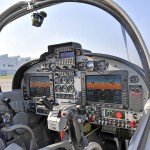 |
Dassault’s New Standards Achieved by Training Providers
January 18, 2013
(Saint-Cloud, France, January 18, 2013) – Dassault Falcon has awarded its two training
partners, CAE and FlightSafety International, certificates demonstrating full compliance with
requirements of the new Falcon Training Policy Manual (FTPM). The certificates cover training
of pilots, maintenance personnel and cabin crew.
“The certificate ensures that training conforms fully with Dassault Aviation requirements and that
the slightest change in aircraft design will immediately be reflected in the training syllabus,” said
Gerard Dailloux, Vice President, Operational Support at Dassault Aviation. “Obtaining them
required an enormous investment in time and resources on the part of our training partners –
testimony to the closeness of our partnership and our mutual commitment to providing the
highest level of training quality and safety to our customers.”
The FTPM is intended to ensure that Falcon customers around the world are trained to the same
high quality standard and equally benefit from the most up-to-date technical information on each
aircraft they operate. To obtain qualification, FlightSafety International and CAE each underwent
a stringent evaluation intended to identify variance from FTPM policy standards and update
instructor skills, courseware and training tools and devices where needed to meet these
standards. The training providers developed a process which involved intensive tracking of
changes to aircraft design and flight documentation and drew heavily on customer feedback and
internal quality audits.
The certificates are valid for two years which reflect the ongoing nature of the approval process
and will be followed by individual aircraft approvals throughout 2013.
Piper Names James Funk VP of Operations
January 15, 2013
VERO BEACH, Fla., Jan. 15, 2013 – Piper Aircraft Inc. has appointed James W. Funk as Vice President of Operations, reporting to President and CEO Simon Caldecott. In his new role, Funk is responsible for aircraft manufacturing operations, production engineering, logistics and quality.
“Jim brings nearly 30 years of operations management, manufacturing engineering and program leadership experience to Piper’s senior leadership team,” said Caldecott. “He has held many leadership positions in electronics and the aerospace industry that will be a direct benefit to Piper’s manufacturing, supply chain and quality functions.”
Before joining Piper, Funk was Bombardier Learjet’s General Manager of Operations for the Learjet 85 program. Prior to that, he was Vice President of Operations for Hawker Beechcraft Corp. and its predecessor, Raytheon Aircraft Co. He was responsible for the company’s turboprop and piston programs. He joined Raytheon in 1984.
Funk has a Bachelor of Science in Industrial Engineering from Trenton State College in Trenton, N.J., and has completed numerous advanced courses in leadership, quality and manufacturing disciplines. He will be relocating to Vero Beach.

“Aeroamistad”
December 18, 2012
Sergio Barriga Kreft, Chile
Viviendo una vida que cada día se torna más y más agitada, ya nos hemos acostumbrados a que lo que hoy es noticia importante, mañana tal vez solo sea un recuerdo y en un futuro no lejano, con certeza, parte del olvido.
Es lo que inevitablemente ha sucedido con Steve Fossett, de cuya imprevista partida, en fecha reciente se han cumplido cinco años.
Empresario de éxito, consultor financiero de renombre, avezado navegante, aventurero impenitente, pero sobre todo aviador de corazón.
Su vida estuvo marcada de desafíos que uno a uno supo vencer, como lo fueran, entre otros: el cruce a nado del canal de La Mancha, el primer cruce del océano Pacífico en solitario en globo, la vuelta al mundo sin escalas, también en solitario en el “Spirit of Freedom”, hazaña que repitiera en su jet monomotor “Virgin Atlantic Global Flyer” y el récord de distancia en vuelo sin escalas de 42.469 km.
Vida plena, pero llena de metas aún por alcanzar que él avizoraba en lontananza.
Por ello, cuando en 2007 en el Dayton Convention Center de Ohio fue incorporado a la National Aviation Hall of Fame, sonriendo respondió a tan merecido homenaje: “Espero que no me hayan dado este reconocimiento porque piensen que mi carrera está terminada, ya que no es así”.
Con toda seguridad, en su mente ya anidaba el que sería su próximo desafío, al que diera inicio el 3 de septiembre de ese año, al despegar en su Bellanca Citabria, en un vuelo de exploración sobre la Sierra Nevada, en busca de un lago seco en el cual batir el récord de velocidad terrestre.
Pero en ocasiones el destino depara lamentables sorpresas y desde ese instante se perdió todo rastro de él, comenzando a tejerse la leyenda, situándolo junto a Eduardo Newbery, al teniente Alejandro Bello, a Jean Mermoz, a Amelia Earhart y a otros grandes de la aviación, que un día en forma inesperada se diluyeron en los cielos del mundo.
Solo en octubre de 2008, al encontrarse estrellados los restos del frágil monomotor en las cercanías de Mammoth Lakes, California, se puso término a tantas especulaciones, debiéndose aceptar la cruda realidad.
Los que supimos de su trayectoria y admiramos su valor, confiamos en que las mismas corrientes que pusieron abrupto fin a su postrer vuelo, hayan cogido su alma transportándola hacia los espacios infinitos. Aquéllos que tanto debe haber anhelado conocer.


